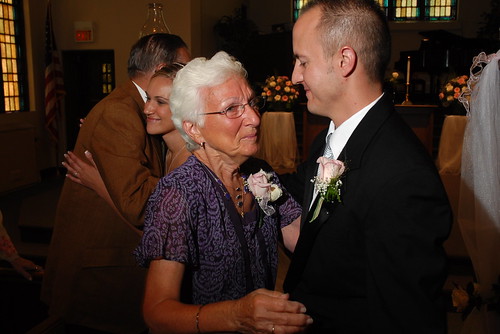
Image : http://www.flickr.com
The tradition of tossing the Bride's bouquet
The significance, as everyone knows, is that the one who catches it will be the next to marry! Originally, it was not a bouquet but a garter that was tossed. This custom of tossing the garter originated in 14th century France. However even when the bride left it dangling around her ankle in order to make the snatching easy, she was considerably mauled. For a time a stocking was tossed, but its removal was neither easy nor graceful. Finally some bride, whose identity has been lost to us, thought of tossing her bouquet and this custom has been followed ever since. Even now, however, some grooms like to follow the old garter tossing custom so that the ushers as well as the bridesmaids may know who among them will be next to marry.
The origin of the wedding reception and wedding refreshments
Marriage feasts have been in existence nearly as long as marriage ceremonies. The early Greeks had a feast at the end of the wedding procession when the bride was conducted to her new home at night. Although usually the Greek custom was not to include women at their banquets, they were invited to wedding feasts.
The wedding cake
This was always an important part of any wedding feast. Where or when it first originated cannot be told it is so ancient a custom. Among certain American Indian tribes, and among the Fiji Islanders, a bride offered her husband a cake of meal. The Romans broke a cake made of salted meal over the bride's head as a symbol of abundance. Many peoples of various nations customarily dropped wheat, flour or cake upon the bride's head, then ate these offerings for good luck. The early Britons baked large baskets of small dry crackers for weddings, and every guest took one home thus the tradition of taking wedding cake home to "dream on." The small cakes gradually increased in size and richness, and, so the story is told, a French chef in London finally had the idea of icing the mass of cakes together the first English-French wedding cake. During the reign of Charles II in England, the elaborate, highly ornamented wedding cakes as we know them first came into being.
Throwing rice, old shoes and other things
The rice-throwing is closely related to the wedding cake itself in fact throwing grain preceded the baking of cakes and the cake developed from that earlier practice. The throwing of grain seemed to involve two symbols, good luck and fertility or abundance.
Among the ancient Assyrians and Jews, when a bargain was made, a man gave his sandal as an indication of good faith. A shoe was the symbol of authority. When the Anglo-Saxons hurled a shoe, it indicated that authority had been transferred. Some authorities believe that the throwing of a shoe can be traced back to the missiles which the bride's father hurled at the robber caveman.
Seating arrangements at weddings
It is said that the practice of seating the groom's family and friends on the right and the bride's on the left derived from the custom of seating honoured guests on the right of the host. On the wedding day, the bride's parents are hosts and the groom's are the honoured guests.
The Bachelor Dinner
This appears to have had its source in Sparta. A Spartan groom always invited his close friends to a supper on the eve of his wedding. The custom is very old and many believe it originated simultaneously in many different lands.
Engraved invitations or announcements
Many centuries ago the monastic schools kept marriage books for royalty. These records were made in the very beautiful handwriting of the monks. Later, formal invitations were issued by Royalty in this handwriting, referred to as script. In 1620 copper plate engraving of script writing was first achieved and gradually the custom evolved of engraved rather than hand written invitations to weddings and other formal affairs.
The Honeymoon
This tradition is as old as from the caveman era, once the man had abducted his bride, he kept her carefully hidden until her father's tribesmen gave up the pursuit and permitted their tempers to cool. Among certain northern European peoples in early centuries, a newly married couple drank a wine made of mead and honey, known as metheglin, for a month after their marriage. A month was then a "moon," and therefore the month during which the wine was drunk became known as the honeymoon. Among certain peoples, seclusion from the world after the marriage ceremony was definitely part of the marriage rites.
Today all couples who can afford it travel to their honeymoon straight after the wedding party has finished.
Match the sparkle in her eyes with an engagement ring designed by you. http://www.MyPinkDiamonds.com presents a range of engagement ring settings & a vast collection of loose diamonds. Design your own engagement ring with http://www.MyPinkDiamonds.com
0 comments:
Post a Comment